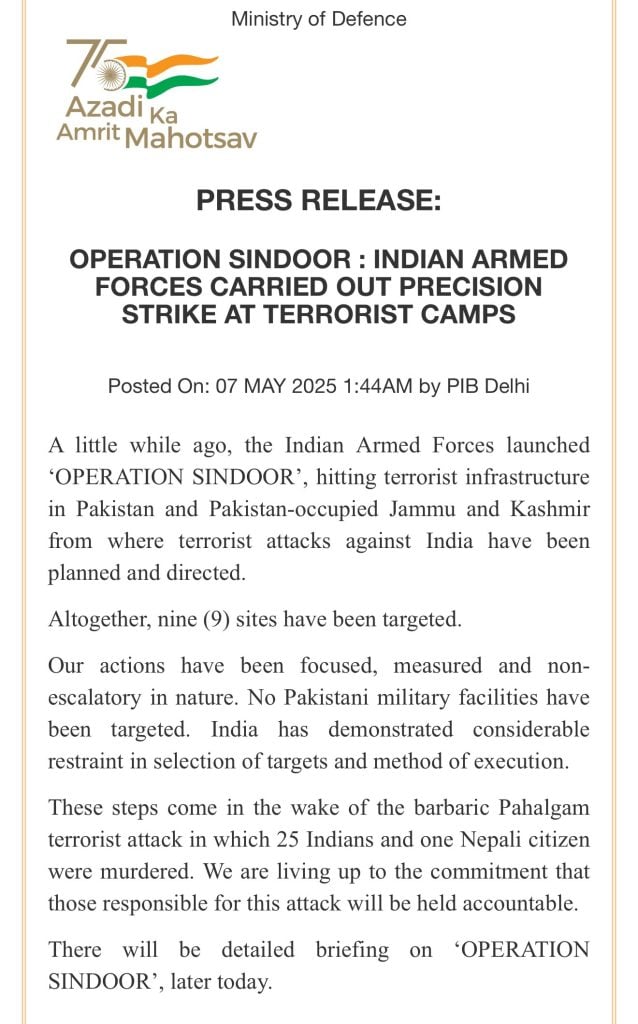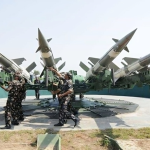In a calibrated yet forceful response to the deadly terrorist attack in Pahalgam last month, the Indian Armed Forces launched Operation Sindoor early Tuesday morning, targeting key terrorist infrastructure in Pakistan and Pakistan-occupied Jammu and Kashmir (PoJK). The precision strikes, announced by the Ministry of Defence, were carried out against nine specific sites identified as operational bases for cross-border terror groups.
The operation follows the April 22 attack in Baisaran Valley, Pahalgam, which claimed the lives of 25 Indian citizens and one Nepali national, most of them non-Muslim tourists. According to Indian intelligence, the perpetrators belonged to Pakistan-based groups and were heavily armed with M4 carbines and AK-47s. The assault sparked nationwide outrage and raised urgent concerns about security preparedness in the region.
“Operation Sindoor was a focused, measured, and non-escalatory strike,” said an official statement from the Ministry. “We took great care to avoid targeting Pakistani military installations and focused solely on locations linked to terrorist activities,” it added, stressing India’s intent to address the threat without provoking broader conflict.

The Ministry noted that the nine targeted sites had direct connections to past and planned attacks, including the Pahalgam incident. Preliminary intelligence suggests the operation achieved high-impact tactical objectives without civilian casualties.
In the wake of the Pahalgam massacre, which exposed a critical lapse in security coordination, India moved swiftly to shore up domestic and cross-border counterterrorism strategies. The attack came just two months after the valley was prematurely opened to tourists, a decision that officials now admit lacked adequate security oversight.
Operation Sindoor is being compared to the 2019 Balakot airstrikes, launched after the Pulwama attack. However, analysts highlight a significant shift in India’s approach. “Unlike Balakot, which drew criticism for its limited tactical effect, Operation Sindoor is being framed as a more precise and intelligence-driven retaliation,” said defence analyst Lt. Gen. (Retd.) R.S. Panag.
Tensions along the Line of Control (LoC) had already been simmering in recent weeks, with Pakistan conducting military exercises and deploying newly acquired Chinese SH-15 155mm self-propelled howitzers near forward positions. Ceasefire violations had also seen a noticeable uptick in early May.
The operation follows closely on the heels of another significant diplomatic milestone — the extradition of Tahawwur Rana, a former Pakistan Army officer and a key figure in the 2008 Mumbai attacks. His transfer to India from the U.S. had already aggravated tensions between New Delhi and Islamabad.
Meanwhile, the Pahalgam attack triggered rare unity in Kashmir’s political and civilian response. Protests and shutdowns in Srinagar, Pulwama, and Anantnag denounced the violence, with demonstrators asserting that the attack violated the spirit of Kashmiriyat — the region’s traditional ethos of communal harmony.

India convened an all-party meeting on April 24, underlining its intent to forge national consensus on counterterrorism. Opposition leaders were briefed on the evolving situation and assured of transparency in the government’s next steps.
As Operation Sindoor’s details continue to emerge, global stakeholders are closely watching whether the action will lead to further escalation or open a path toward de-escalation. India has reiterated its resolve to act firmly yet responsibly, emphasizing that its fight is against terrorism — not the people or the state of Pakistan.
A full briefing by the Ministry of Defence is expected later today, outlining operational details and next steps in India’s evolving security strategy.













